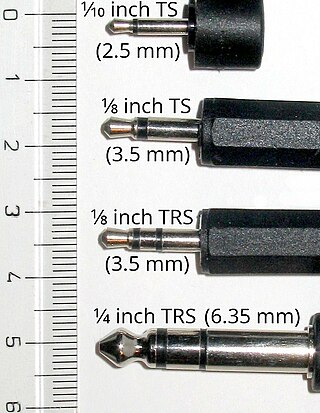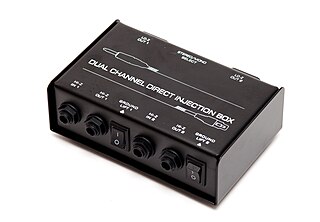Related Research Articles

A disc jockey, more commonly abbreviated as DJ, is a person who plays recorded music for an audience. Types of DJs include radio DJs, club DJs, mobile DJs, and turntablists. Originally, the "disc" in "disc jockey" referred to shellac and later vinyl records, but nowadays DJ is used as an all-encompassing term to also describe persons who mix music from other recording media such as cassettes, CDs or digital audio files on a CDJ, controller, or even a laptop. DJs may adopt the title "DJ" in front of their real names, adopted pseudonyms, or stage names.

A mixing console or mixing desk is an electronic device for mixing audio signals, used in sound recording and reproduction and sound reinforcement systems. Inputs to the console include microphones, signals from electric or electronic instruments, or recorded sounds. Mixers may control analog or digital signals. The modified signals are summed to produce the combined output signals, which can then be broadcast, amplified through a sound reinforcement system or recorded.

Surround sound is a technique for enriching the fidelity and depth of sound reproduction by using multiple audio channels from speakers that surround the listener. Its first application was in movie theaters. Prior to surround sound, theater sound systems commonly had three screen channels of sound that played from three loudspeakers located in front of the audience. Surround sound adds one or more channels from loudspeakers to the side or behind the listener that are able to create the sensation of sound coming from any horizontal direction around the listener.

Multitrack recording (MTR), also known as multitracking, is a method of sound recording developed in 1955 that allows for the separate recording of multiple sound sources or of sound sources recorded at different times to create a cohesive whole. Multitracking became possible in the mid-1950s when the idea of simultaneously recording different audio channels to separate discrete "tracks" on the same reel-to-reel tape was developed. A "track" was simply a different channel recorded to its own discrete area on the tape whereby their relative sequence of recorded events would be preserved, and playback would be simultaneous or synchronized.

A phone connector is a family of cylindrically-shaped electrical connectors primarily for analog audio signals. Invented in the late 19th century for telephone switchboards, the phone connector remains in use for interfacing wired audio equipment, such as headphones, speakers, microphones, mixing consoles, and electronic musical instruments. A male connector, is mated into a female connector, though other terminology is used.

Monaural or monophonic sound reproduction is sound intended to be heard as if it were emanating from one position. This contrasts with stereophonic sound or stereo, which uses two separate audio channels to reproduce sound from two microphones on the right and left side, which is reproduced with two separate loudspeakers to give a sense of the direction of sound sources. In mono, only one loudspeaker is necessary, but, when played through multiple loudspeakers or headphones, identical signals are fed to each speaker, resulting in the perception of one-channel sound "imaging" in one sonic space between the speakers. Monaural recordings, like stereo ones, typically use multiple microphones fed into multiple channels on a recording console, but each channel is "panned" to the center. In the final stage, the various center-panned signal paths are usually mixed down to two identical tracks, which, because they are identical, are perceived upon playback as representing a single unified signal at a single place in the soundstage. In some cases, multitrack sources are mixed to a one-track tape, thus becoming one signal. In the mastering stage, particularly in the days of mono records, the one- or two-track mono master tape was then transferred to a one-track lathe used to produce a master disc intended to be used in the pressing of a monophonic record. Today, however, monaural recordings are usually mastered to be played on stereo and multi-track formats, yet retain their center-panned mono soundstage characteristics.

A DI unit is an electronic device typically used in recording studios and in sound reinforcement systems to connect a high output impedance unbalanced output signal to a low-impedance, microphone level, balanced input, usually via an XLR connector and XLR cable. DIs are frequently used to connect an electric guitar or electric bass to a mixing console's microphone input jack. The DI performs level matching, balancing, and either active buffering or passive impedance matching/impedance bridging. DI units are typically metal boxes with input and output jacks and, for more expensive units, “ground lift” and attenuator switches.
Fantasound was a sound reproduction system developed by engineers of Walt Disney studios and RCA for Walt Disney's animated film Fantasia, the first commercial film released in stereo.
Automatic double-tracking or artificial double-tracking (ADT) is an analogue recording technique designed to enhance the sound of voices or instruments during the mixing process. It uses tape delay to create a delayed copy of an audio signal which is then played back at slightly varying speed controlled by an oscillator and combined with the original. The effect is intended to simulate the sound of the natural doubling of voices or instruments achieved by double tracking. The technique was developed in 1966 by engineers at Abbey Road Studios in London at the request of the Beatles.

A noise gate or simply gate is an electronic device or software that is used to control the volume of an audio signal. Comparable to a compressor, which attenuates signals above a threshold, such as loud attacks from the start of musical notes, noise gates attenuate signals that register below the threshold. However, noise gates attenuate signals by a fixed amount, known as the range. In its simplest form, a noise gate allows a main signal to pass through only when it is above a set threshold: the gate is "open". If the signal falls below the threshold, no signal is allowed to pass : the gate is "closed". A noise gate is used when the level of the "signal" is above the level of the unwanted "noise". The threshold is set above the level of the "noise", and so when there is no main "signal", the gate is closed.
Dolby Stereo is a sound format made by Dolby Laboratories. It is a unified brand for two completely different basic systems: the Dolby SVA 1976 system used with optical sound tracks on 35mm film, and Dolby Stereo 70mm noise reduction on 6-channel magnetic soundtracks on 70mm prints.

Monk's Music is a jazz album by the Thelonious Monk Septet, which for this recording included Coleman Hawkins and John Coltrane. It was recorded in New York City on June 26, 1957, and released in November the same year.
Panning is the distribution of an audio signal into a new stereo or multi-channel sound field determined by a pan control setting. A typical physical recording console has a pan control for each incoming source channel. A pan control or pan pot is an analog control with a position indicator which can range continuously from the 7 o'clock when fully left to the 5 o'clock position fully right. Audio mixing software replaces pan pots with on-screen virtual knobs or sliders which function like their physical counterparts.

There are a number of well-developed microphone techniques used for recording musical, film, or voice sources or picking up sounds as part of sound reinforcement systems. The choice of technique depends on a number of factors, including:
An audio signal is a representation of sound, typically using either a changing level of electrical voltage for analog signals, or a series of binary numbers for digital signals. Audio signals have frequencies in the audio frequency range of roughly 20 to 20,000 Hz, which corresponds to the lower and upper limits of human hearing. Audio signals may be synthesized directly, or may originate at a transducer such as a microphone, musical instrument pickup, phonograph cartridge, or tape head. Loudspeakers or headphones convert an electrical audio signal back into sound.

Center channel refers to an audio channel common to many surround sound formats. It is the channel that is mostly, or fully, dedicated to the reproduction of the dialogue of an audiovisual program. The speaker(s) connected to the center channel are placed in the center of and behind the perforated projection screen, to give the effect that sounds from the center channel are coming from the screen. In many home surround sound units, the center channel is positioned above or below the video screen.

In sound recording and reproduction, audio mixing is the process of optimizing and combining multitrack recordings into a final mono, stereo or surround sound product. In the process of combining the separate tracks, their relative levels are adjusted and balanced and various processes such as equalization and compression are commonly applied to individual tracks, groups of tracks, and the overall mix. In stereo and surround sound mixing, the placement of the tracks within the stereo field are adjusted and balanced. Audio mixing techniques and approaches vary widely and have a significant influence on the final product.

Record is a music software program developed by Swedish software developers Propellerhead Software. Designed for recording, arrangement and mixing, it emulates a recording studio, with a mixing desk, a rack of virtual instruments and effects and an audio and MIDI sequencer. Record can be used either as a complete virtual recording studio in itself, or together with Propellerhead Software's Reason.

Equalization, or simply EQ, in sound recording and reproduction is the process of adjusting the volume of different frequency bands within an audio signal. The circuit or equipment used to achieve this is called an equalizer.
In audio, recording, and music, pumping or gain pumping is a creative misuse of compression, the "audible unnatural level changes associated primarily with the release of a compressor." There is no correct way to produce pumping, and according to Alex Case, the effect may result from selecting "too slow or too fast...or too, um, medium" attack and release settings.